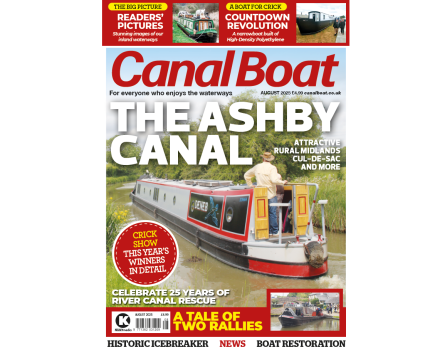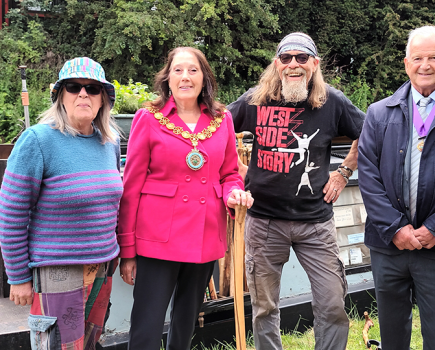As the canal system continues to suffer the after-effects of the hot dry early summer, we ask the Canal & River Trust what the prognosis is for routes affected by water shortage, and for the longer term future
“The bad news is that there’s no good news. But the good news is that there’s no more bad news…”
It seems that this old and not terribly witty couplet rather drily (excuse the pun) sums up the situation facing the canals at the end of the summer as a result of the driest May / June / July period in almost a century. As far as the ‘no good news’ line is concerned: the three trans-Pennine routes (Rochdale, Huddersfield, Leeds & Liverpool) and the Macclesfield / Peak Forest all have lengthy sections closed indefinitely as a result of low reservoir levels, they have more recently been joined by the Ribble Link and Hazelhurst Locks on the Froghall line of the Caldon, and there are overnight closures in place at various locks elsewhere. And as the Canal & River Trust’s head of hydrology Adam Comerford explained to Canal Boat, as we went to press there didn’t look like any realistic prospect of them reopening any time soon.
Sure, it’s impossible to second-guess the British weather, but he predicts that in most of these places it would take at least four weeks of wet weather to replenish stocks enough for any reopenings. In what he describes as a ‘hockey stick curve’ because of its shape, any rain that falls will largely go into reducing the ‘soil moisture deficit’ (i.e. soaking into the dry soil) with no significant effect on flows in streams (and therefore into reservoirs), before it eventually hits the point where the soil is saturated and the reservoir levels suddenly start to shoot up. Even with a prolonged spell of wet weather, that would take a month (which at least means the engineers working on the problems at Marple – see news story, page 7 – have some notice of when the locks might be wanted for navigation again); realistically with the more typical late summer / early autumn weather mix, we’re quite likely to be looking at mid autumn a least before the closures can come off.
But the ‘no more bad news’ line? Adam Comerford’s thoughts on the need for any further restrictions in the future are less pessimistic. Most of the system remains open, as we went to press no more complete closures were planned, and CRT didn’t see any likelihood of any more being needed before the end of the peak boating season and the decline in demand. He feels that some locks which are already shut overnight may see reductions in opening hours, and there may be a need to bring in overnight closures on the Monmouthshire & Brecon, but nothing more drastic. It’s helped by the fact that even if the dry weather were to return for the end of summer and early autumn, the forecasts indicate that it wouldn’t be anything like as hot – earlier in the summer, canals were losing an inch of water a day just to evaporation in the very high temperatures. Even on the Trent & Mersey, which has borne the brunt of extra traffic displaced from other waterways, CRT hopes to get through – and may even be able to relax overnight restrictions.
On the other hand, on the canals which are already closed, things surely can’t get any worse? Well, actually they can. You might think that the complete closure of all locks from Wigan to Leeds would see the Leeds & Liverpool’s reservoir levels start to recover or at least stabilise, but in fact it takes something like 20 percent of the normal supply just to cope with losses such as evaporation and transpiration (tree roots sucking up water) in order to maintain the level in the longer pounds of the closed canal (the shorter ones in lock flights having generally be allowed to drop). If this can’t be maintained when the reservoirs hit rock bottom, there could be anything from mass fish deaths to slippage of canal banks not supported by the usual weight of water, and moored boats being stranded high and dry with no access to water points and sanitary stations. So CRT is analysing the situation and drawing up contingency plans to prevent this by inserting stop planks and using pumping to retain what water it has in ‘safe haven’ sections if the worst comes to the worst.
But in the longer term, what can be done to prevent a recurrence? Adam Comerford makes the point that this really is an exceptional year, even compared to previous dry years. 2010 saw very dry weather over a much more local area, while there was a ‘slow burn’ less intense dry period for months on end over a wider area in 2011-12. This year has combined hot, very dry weather and a wide geographical spread. How likely is a repeat, given how it’s affected canals (such as the Caldon) which very seldom suffer?
As such it leads to the same quandary as (for example) railway operators and airports considering spending money on precautions for dealing with snow – why plan for a once in decades event, when there’s always something else that the money could be spent on instead which would be used every day?
That’s not to say CRT is doing nothing: there is a long-term project under way working on a Water Resources Strategy, aiming to target improvements where they’re most likely to be of regular use, and some of the schemes are into the detailed design stages. These include plans for the Rochdale, where the aim is to make better use of the large Hollingworth Lake reservoir (where the problem is that it doesn’t supply the summit level) by combining it with backpumping. And on the Leeds & Liverpool CRT is looking to combine new feeds from river sources on the Lancashire side of the summit with backpumping to raise the water to where it’s needed. At the same time, smaller projects would see dredging and vegetation clearance on some of CRT’s feeders, many of which have become silted: this is the subject of analysis to decide where it would provide best value for money spent.
In the long term, CRT sees possibilities for working with the drinking water companies (which are currently into their five-year planning cycle) on investing in water transfer systems using the canals, which could bring in extra income for the Trust as well as helping to keep the system going in droughts.
And finally, a study into possible reinstatement of water-saving side-ponds at locks has drawn up an inventory of surviving side-ponds, and concluded that while wholesale reinstatement would be challenging and of doubtful value, there are places where it could make sense – especially with volunteer lock keepers to ensure that they are used correctly.
For example there are out-of-use sideponds at Hazelhurst Locks on the Caldon: might their use have helped to stave off closure?
See canalrivertrust.org.uk for latest details of closures and restrictions.







